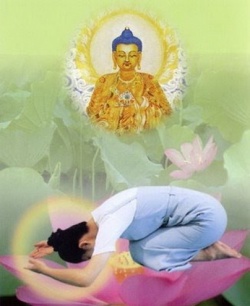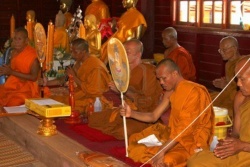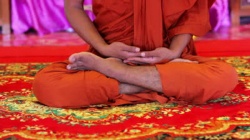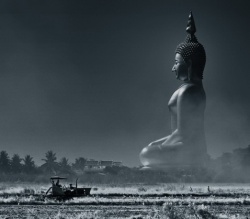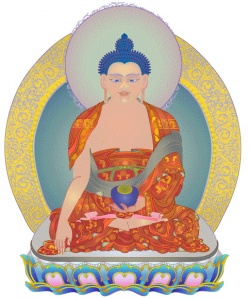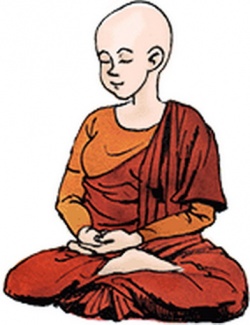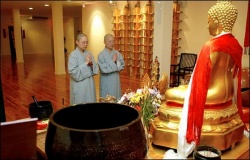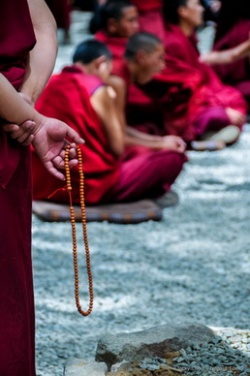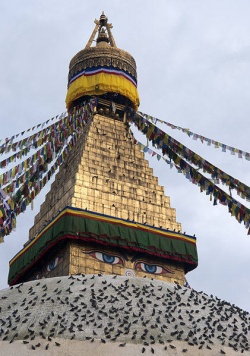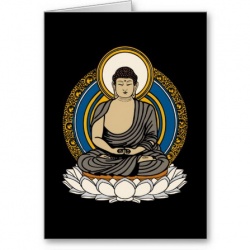Disrobing the Dharma practising and teaching it free of the male monastic norm
by Winton Higgins
— a discussion document for the Insight Teachers’ Circle of Australia annual meeting, 13–15 August 2010
The quest for purity is pursued by rejection. It follows that when purity is not a symbol but something lived, it must be poor and barren.
Mary Douglas1
This paper reflects on how secular insight meditation is evolving, and in the first instance addresses my fellow teachers in that dharmic sub-tradition in Australia. Its point of departure is the commonly noted one, that we in the west still have a long way to go in both reviving the project and spirit of the original buddhadharma, and in adapting them to our own culture and lay circumstances. In particular, we need to look more critically at our inheritance (including unexamined assumptions) from religious Buddhism.2
We are trying to develop dharma practice by returning to the Buddha’s own teaching and recalibrating it for our time, place, and lay situation; and yet we are the immediate heirs of a contrasting monastic (religious-Buddhist) development. In engaging with this tension, we need to overcome three intimately related biases in our religious-Buddhist inheritance: its gendered nature, its regimentation, and its hyper-renunciatory conception of the good life. These biases, I suggest, stymie the dharma’s awakening project in the modern world.
I’m not setting out to denigrate the monastic path of practice, or any individual’s choice to adopt it, or any project to reform it from within. Rather, I’ll question its influence and presumed superiority over the lay path (whence springs its normative authority in the religious-Buddhist world) in our own time and place. The perception of monasticism as normative for all dharma practitioners induces us to take for granted – and defer to – monastic criteria as the measure of all dharma practice and ways of life.
These criteria in turn import a radically different conception of the good life from the secular one that actually informs our own real-world moral priorities, which grow from our western cultural roots. We need to resolve this hiatus if we’re to create a coherent spiritual path.
Historical background
The Buddha developed dharma practice free of large-scale institutions, among scattered lay adherents and small bands of ordained followers. He did so within a broader Indian spiritual culture, one that emphasised the miseries of ordinary human life, and consequently venerated renunciation and other-worldliness.3 He overthrew a range of reigning conceptions in the religious and social life of his time and place. But like any other human being, he remained a child of his culture, not least when it came to the central idea of liberation (moksha) premised on the renunciation of worldly life. The drastic separation of the sacred and the profane was there from the start.
Matters took another turn again when, in the millennia following the Buddha’s death, the dharma became religified and institutionalised in often large-scale monastic form.
All but the tiniest human collectivities require institutions. Spiritual, political and social movements in particular depend on institutions to preserve and renew their traditions, and to bring their adherents together in common practices which enact shared understandings of the way things are. Compared to other religions and spiritual movements, Buddhism has relied on the institution of monasticism to a unique degree. The greatest achievement of Buddhist monasticism has been its own survival. On that historical basis, the dharma and its practice remain available to us today.
A couple of false inferences are commonly drawn from this history, starting with the idea that the dharma could not have survived outside of monastic institutions. In the history of religion, other models seem to have worked as well, such as lay priesthoods or communitarian lay sects. The inference that only monasticism could have done the job spawns another: that dharmic life must ever remain dependent on monasticism as its vital core and the source of spiritual authority, even (or especially) in situations where lay practitioners outnumber monastic ones. The Theravada in particular – the historical trustee of insight meditation practice – holds to these dubious truisms as central articles of faith. This paper will focus primarily on the Theravadin case, though I suspect most other Buddhist monastic orders vary from it only by degree.
In what follows I want to suggest that the monastic preservation of the dharma and its practice has come at the price of gender bias, strained conformity and moral confusion – all baked into the prescriptions for dharma practice that we inherit. As teachers and practitioners we need to correct for them, and (as we shall see) several currents in dharmic meditation today are doing just that, albeit without explaining how and why they are doing so. This reform will not prove straightforward. The more subtle distortions are so embedded in the supposedly ‘pristine’ dharma, and in inherited meditative approaches based on it, that they operate at a subliminal level. Here I’ll propose the male monastic norm as my central working concept in making the distortions in question visible.
The male monastic norm
Both popular and academic idiom usually carries the subliminal assumption that the normal cricketer, rock star, citizen, worker, dentist, lawyer, spiritual practitioner, passenger, driver, etc etc, is male, and that female cases virtually all such categories are exceptional. We refer, for instance, to the all-male Rolling Stones simply as a rock band, and the equally gender-exclusive Australia XI simply as a cricket team, while we refer to the Runaways as a women’s rock band, and to the Southern Stars as a women’s cricket team. We don’t call the first two entities a men’s rock band and a men’s cricket team, because we assume that they exemplify universals – rock music as such, cricket as such – while the second two (female) entities constitute exceptional cases. In other words, wherever abstract individuals (or humanity as a whole) are invoked, our language carries the assumption of maleness as the norm, and femaleness as the exceptional case that calls for special mention.
Feminists call this phenomenon the male norm.4 All patriarchal societies generate social and linguistic habits that induce and perpetuate it. Until recent times the male norm was much more explicit than it is in the west now – back in the days when ‘Man’ stalked our language, claiming to represent humanity as a whole. Now feminist linguistic reforms have driven Man himself underground, but the male norm endures subliminally in our linguistic habits, and thereby in our unexamined attitudes.
In this way, the norm makes the exclusion, marginalisation and subordination of women in institutions and society at large appear natural, and so normalises them. As the limited success of liberal-feminist reforms in work life have shown, unless we render the male norm visible and recognise gender difference, naïve anti-discrimination laws simply invite women to become honorary men in order to gain ‘equality’, with inevitably dispiriting results.5
There has been nothing subliminal or subtle about the exclusion and marginalisation of women in Buddhist monastic life, least of all in the Theravada. It has been – and largely remains – quite explicit and unapologetic. Nonetheless, we need to note how institutionalised monastic patriarchy has moulded conceptions of the normal dharma practitioner, such that the male norm survives even in those isolated pockets of reform which have recently ordained women, and introduced gender-inclusive linguistic reforms, such as translating bhikkhu as ‘practitioner’ instead of ‘monk’. But if (as I will suggest) the institution’s model of spirituality is inherently masculine, we’re once again seeing women being offered ‘equality’ in the form of an invitation to become honorary men.
This problem, too, has been there almost from the beginning. When we contrast the expressions of spiritual aspiration in the verses of the first-generation nuns and monks (the Therigata and Theragata respectively), two divergent approaches to spiritual life emerge: a female one based on interconnectedness, and a male one based on emotional evisceration through rejecting all human ‘attachments’. Yet both approaches pursue awakening and moksha.
Given that monastic elites over the succeeding two millennia have been exclusively male, and monastics of all ranks virtually so, the emotionally eviscerated masculine version of spirituality – an extreme and contextless version of renunciation, as we’ll see – has easily triumphed and become self-evidently normative within religious Buddhism. The male model of spirituality came to stand for the sacred, the pure life as defined by the monastic rule (vinaya), and what fell outside it was spurned as impure and profane.6
In what form has male spirituality secured its dominance? To understand that, we need to look at the influence of institutionalisation as such on Buddhism and its practice, and so plumb a further dimension of the male monastic norm.
Religious Buddhism and the norm’s institutional matrix
Religious institutions present themselves as straightforward expressions and vehicles of their founders’ teachings. Their only reason for being, they claim, is to faithfully preserve, exemplify and propagate those teaching, in the letter and the spirit. Their adherents overwhelmingly take these claims at face value. Yet a moment’s critical reflection on their histories will reveal a startlingly different pattern.
Take the Holy See, for a dire example. Originating in the fourth century, it developed to propagate Jesus’ teaching of universal love, peace and humility. But by the 11th century, the pope was announcing breathtaking ambit claims to spiritual authority as ‘the vicar of Christ on earth’, and the Holy See itself had become the most powerful and well-resourced military apparatus of the time. It bloodily pursued territorial expansion in successive crusades from 1095, amid widespread rape, pillage and genocide. It has continued to express hubris and practise Realpolitik ever since, usually expressed in support for reactionary causes, such as fascism in the 20th century. All the while Jesus and his mother have continued to adorn the masthead, and some of their genuine followers have been able to function within its far-flung communion.
This case illustrates the universal pattern in large-scale institutional religion whereby institutional imperatives trump the founder’s teaching. The first item on any institution’s agenda is its own perpetuation, which usually implies its own expansion as a buffer against adversity. Beyond that, each institution crystallises around a specific definition of the problem that led to its founding, and this development can lead it to thwart its wider purposes.7
For the Holy See, the problem was how to secure the survival and growth of Christianity in the war-torn Mediterranean region during the dark and middle ages. For Buddhist monasticism, the challenge of survival and propagation went hand-in-hand with the task of reliably bringing ever larger numbers of male renunciants to (some version of) spiritual fruition.
The development of institutionalised religions of every stripe converges around external and internal imperatives which exercise a strong influence on their doctrine and practice. Firstly, they must promote social integration and political passivity, in order to gain the protection of socio-economic elites and temporal rulers. And they must offer solace and existential certitudes (including rituals around major life events and transitions) to the wider populace, on whose support they depend. In these ways religious institutions usually prop up the status quo and existing rulers’ legitimacy, however transgressive those rulers might be. Modern Buddhist examples include the Japanese Zen hierarchy’s support for the emperor system and military aggression in the crucial pre-war and world war 2 years, and the Sinhalese Theravadin elite’s support for existing temporal power-holders in the latter’s dubious enterprise, in recent troubled times.8
Secondly, religious institutions – in common with all human collectivities – generate internal power struggles that in turn foster dogmatism, hierarchies, authoritarianism and enforced orthodoxy, since doctrine is a principal power resource for elites in religious settings.9 The greater the fit between a fixed doctrine and a generic, standardised spiritual practice, the more secure is the hold of the institutional elite. The standardised practice then becomes its principal stock-in-trade in its competition with other religions and sects.
Buddhist monasticism belongs to an important subset of institutional life called total institutions – ones which regulate the whole life process of their members or inmates. As well as religious orders, the main examples include the military, prisons and asylums of various sorts, and boarding schools. Apart from intensifying the usual characteristics of institutional life, not least pecking orders, they tend to generate regimentation and conformity, symbolised by uniforms and daily rituals. They employ formal and abstract micro-managing techniques (‘one size fits all’), and equate compliance with merit, maturity and ‘progress’, all of which they validate as ‘attainments’. Of course, any exercise of power will usually provoke resistance, and what I’m describing here are tendencies that resistance may deflect in some instances and various ways. Nevertheless, the tendencies usually have their way.
The institutional matrix of our immediate dharmic inheritance in Theravadin monasticism, then, could hardly diverge more from the social and historical setting into which the buddhadharma was born on the one hand, and on the other, the one in which we in the west seek to retrieve and practise it today. We have inherited the buddhadharma, but with notable accretions (practices and supporting doctrines deeply imbued with institutional biases) and radical absences (creativity and plurality). We must now account for them, since the monastic institutional matrix inflects every aspect of our inherited dharmic practices.
Standardised spirituality: the male monastic norm
In this paper, and the one I presented at last year’s ITCA meeting, I’ve emphasised how historical circumstances (or contingency) – especially culture and institutional frameworks – colour developments in both the theory and practice. They come together in the monk as the normal dharma practitioner. The gross form of this identification is the widespread belief in traditional Theravadin circles that only a monk (gender specificity intended) can aspire to full awakening. If one is not already monk, or at least a man, one should earn merit in aid of a ‘fortunate’ male rebirth. In more sophisticated Theravadin circles, a monastic of either sex may so aspire, but the path consists of conforming to a monk’s way of life and practice.
The monastic rule (vinaya) and monastic culture proscribe the normal affective human bonds – to spouse, children, parents, family and friends – as ‘attachments’, impediments to practice. Also ruled out is work, not least participation in any organised work or professional life outside the monastery. All aspects of life that individuate us and flesh out a human life are thus systematically excluded.
What is left is an extremely stripped-down way of life, one regimented by a total institution and its rules – rules that annul a recruit’s own cultural and ethical starting points.
The Buddhist monastic codes and the way Western monks tend to worship them and follow them unquestioningly is a perfect example of this, [writes Jason Siff, a former Theravadin monk). Many Western monks and nuns try to obey the rules as best they can, even though some of the rules do not make sense from the point of view of the culture they come form.
Western lay practitioners also try to comply with these codes, on and off the cushion:
And this may not be limited just to forcing upon themselves the new rules of conduct but may even extend to restrictions on how they think and feel. Some people may come to believe they should never feel their anger or listen to their cravings, as if our emotions could obey a decision not to feel compelled to act on them. Some may even go so far as to believe that adherence to this new code of behavior will enable them to no longer feel the undesirable feelings. The practice becomes not about cultivating beneficial qualities but about suppressing unwanted behaviors, controlling thoughts and feelings, and acting in ways that can at times be false and misleading.10
The male monastic norm on the cushion
As meditators soon find out, our meditation experience reflects our actual life process. Traces of our life predicaments surface when we sit. Meditation practices incubated in monasteries (and the doctrines that support them) reflect a sparse, regimented way of life that is a far cry from lay life, not least lay life in the contemporary west. A regimented way of life attracts generic, standardised and technicised approaches to meditation – the formulaic vipassana techniques. They subject meditators to an institutionalised discipline in order to yield conformable outcomes. Yet these techniques, which presuppose a uniform monastic way of life, are still taught as ‘the one true way’ for all human beings in all walks of life and circumstances. When we apply these techniques, we are invited to become quasi-monks and instructed to reject a great deal of our actual meditative experience, which arises from our actual way of life. We ‘meditate in a way that feels rigid, pressured, and result oriented’, as Jason Siff puts it.11
To the extent that we can temporarily emulate the way of life and the meditation experience of Theravadin monks, we will find our efforts in vipassana meditation validated. When our unmonkish way of life erupts into our meditative experience in the form of thoughts, fantasies, plans and passions, we are told (more or less judgmentally) that this content is not appropriate to meditation: it constitutes distractions, hindrances, ‘monkey mind’, wandering, and so on. Such dismissals express the male monastic norm and the central trope of religious Buddhism, that monasticism is a superior way of life to lay life. Monastics are ‘venerable’, lay people are not. We find ourselves back in the sacred/profane dualism – a matter I’ll return to.
The regimented, sparse monastic way of life rules out individuals’ having unique psychodynamics based on highly variegated life experiences and emotional engagements. And so we find the enormous range of the Buddha’s own non-technical teaching to diverse, real-world questioners and practitioners in the suttas replaced, a few centuries after his death, by one formal, technical and abstract discourse about meditation. That discourse is the Abhidhamma, a male monastic product par excellence.
Yet two of the Abhidhamma’s monastic proponents today, U Rewata Dhamma and Bhikkhu Bodhi, describe it as ‘the authoritative recension of the Buddha’s teaching’; ‘a philosophy, a psychology, and an ethics’ that has spawned today’s formulaic vipassana techniques. They praise its ‘abstract and highly technical systematization of the doctrine…[T]he principles of the doctrine have been methodically organized, minutely defined, and meticulously tabulated and classified.’12
For Rewata and Bodhi, the Abhidhamma’s suppression of references to the meditator’s subjectivity and psychodynamics accounts for its superiority over the word of the Buddha in the suttas:
[The suttas) were expounded by the Buddha under diverse circumstances to listeners with very different capacities for comprehension. They are primarily pedagogical in intent, set forth in the way that will be most effective in guiding the listener in the practice of the teaching and in arriving at a penetration of its truth. To achieve this end the Buddha freely employs the didactic means required to make the doctrine intelligible to his listeners. He uses simile and metaphor; he exhorts, advises, and inspires; he sizes up inclinations and aptitudes of his audience and adjusts the presentation of the teaching so that it will awaken a positive response…
In contrast to the Suttas…the Abhidhamma takes no account of the personal inclinations and cognitive capacities of the listeners; it makes no concessions to particular pragmatic requirements. It reveals the architectonics of actuality in an abstract, formalistic manner utterly devoid of literary embellishments and pedagogical expedients…The Abhidhamma method of exposition…rigorously restricts itself to terms that are valid from the standpoint of ultimate truth (paramatthasacca): the dhammas, their characteristics, their functions, and their relations.13
Given monasticism’s institutional dominance in the Theravadin world, then, the Abhidhamma and the standardised techniques extrapolated from it came to mask, masquerade as, and displace the Buddha’s own accounts of meditative process and experience, and the possibilities they opened up.14 The Buddha’s open-ended experiential teaching gave way to a tableau of metaphysical truth claims.
Where the Buddha described meditative processes and experience, the Abidhamma-derived techniques prescribe them and confer attainments for compliance. These formulaic techniques enjoin us to bat away and denigrate a great deal of our actual meditative experience – the stuff of our individual psychodynamics and the inescapable traces of our multifaceted lives. In Jack Engler’s terms, technique-driven meditation can free us from our ontological selves (the core belief in I, me and mine), while leaving our psychological selves untouched by the practice.15 The recurring pattern of ‘realised’ teachers acting in destructive ways towards their students and sanghas provides a striking example of this one-sided spiritual development.
The illuminating, transforming and liberating effect of meditation is thus limited to a narrow area of our being, and the rest is left in darkness at worst; or at best, to be accessed through other disciplines. An effective lay insight practice, by contrast, needs to embrace both our ontological and psychological selves – our whole being, ‘the whole catastrophe’. Awakening needs to be a whole-of-being affair.
Freeing insight meditation from the norm
For reasons I will come to in the next section, the Zen tradition long ago took a tentative step out of formulaic practices with the development of shikintaza, ‘just sitting’. In our own time, Zen and post-Zen meditation teachers, such as Charlotte Joko Beck and Toni Packer, have pioneered non-formulaic approaches to dharmic meditation. As Barry Magid – a student of Joko Beck’s – puts it, the point is to invite the mind to ‘automatically appear and display itself’, its contents as a whole.16 This is a mind that suffers no inhibitions born of institutional scholasticism and technical instructions.
Now Jason Siff has performed the same service for the post-Theravadin world of secular insight meditation in suggesting we ‘unlearn meditation’.17 In his approach we honour every moment of our meditative experience. We allow the whole of it, and receive it with gentleness, kindness and interest, even when it arises when we’ve set out to apply some learned technique or other. All meditation instructions contain embedded concepts and beliefs, and by allowing what comes up, the concepts embedded in a technique gradually reveal themselves. Inevitably, many such concepts and beliefs concern how we live, and they will contain traces of the male monastic norm in the form of self-judgments.
Renunciation and the good life
I’ve emphasised the way in which our meditation experience arises out of our way of life; our meditation practice and expectations need to be appropriate to the choices and priorities we in fact live by. But meditation powerfully transforms us, so that we choose, prioritise and live more wisely and insightfully. As we have seen, however, inherited approaches to meditation contain embedded concepts (the male monastic norm above all) about how we should live. If we aren’t careful, the norm will follow us home and start scrambling our priorities and disparaging aspects of our lives that would otherwise appear fulfilling and vital aspects of our spiritual path. At the core of this problem is idolatry around a particular version of renunciation baked into the norm.
The Theravadin vinaya establishes the definitive version of renunciation and purity in the Buddhist world. But a moment’s thought will reveal that renunciation is a relative concept. Siddhattha Gotama’s five ascetic colleagues were ultimate renunciants engaged in an extreme spirituality that kept them on the verge of death and in the grip of delusion. When he began to eat at least one square meal a day, they accused him of wallowing in luxury. His teaching of the middle way rejected that extremity of renunciation, but as a child of a spiritual culture that denigrated worldly life, he nevetheless left a pronounced renunciatory legacy at odds with later cultures that came to host the dharma.18
Renunciation is the voluntary giving up or abandonment of something that one might otherwise have access to and enjoy. All the great wisdom traditions – religious and secular, western and otherwise – counsel renunciation of pursuits which, if they get or retain the upper hand, hamstring our human maturation and spiritual development. The obsessive pursuit of sensual pleasure, luxury, wealth, fame, power and vengeance appear in all the relevant lists of preoccupations we should renounce. This sort of renunciation – and the day-to-day personal insight and restraint required to give effect to it – must form part of dharma practice in particular.
These days and in this society, many mature people renounce such things as a second car in the family, excessive air travel (given aviation’s contribution to global warming), unnecessary consumption, clandestine affairs, tax avoidance, open or underhand acts of aggression, dishonesty, self-interestedly callous politics, and so on. These are morally meaningful forms of renunciation that ward off threats to well-being – one’s own, and that of others. Like all sound moral judgments, they are situated; they arise from both general principles and the particular situations that we, as moral agents, find ourselves in.
The renunciation baked into the male monastic norm is not of this order. Virtually none of the prohibitions in the vinaya have any ethical content, and because it defies updating, it doesn’t address new contexts and predicaments. Crucially, its prohibitions cut off the development of vital human capacities. By contrast, for the ancient Greeks and their cultural heirs (including us), the good life consists in cultivating positive human capacities – self-knowledge; reason; friendship and other strong human/familial bonds, the virtues; piety; and an ongoing contribution to one’s community (or ‘public affairs’). For Freud, speaking from a modern western viewpoint, ‘love and work are the cornerstones of our humanness.’
Most of us today cultivate, and find deep meaning in, several forms of love – parental, filial, sexual, spousal, platonic. Perhaps intimacy goes to the core of all these forms of love. To be truly intimate with another human being is a very strong practice: it requires us to abandon the last vestiges of our narcissism and to truly grow up to self-responsibility and empathy. The world of work has a similar maturing and meaning-creating effect, disciplining us to work to objective standards and to cooperate with others; this is where Freud’s ‘reality principle’ kicks in. As dharma practitioners we can let the Buddha’s noble eightfold path guide us as we love and work.19
When the dharma came to ancient China, it encountered a much more optimistic, humanistic an earthy culture than its Indian counterpart, and east-Asian Buddhism began to close the gap between the sacred and the profane, monastic and lay. Nirvana and samsara were declared to be not two, and the path ran through everyday human life.20 Here is a modern echo of that life-affirming dharma:
If you are a new mother or father [writes Susan Murphy, a Zen roshi) you are someone who has just been given the teacher of your lifetime…Someone has arrived who will grow you up, season you, teach you to let go at every stage of the most profound attachment. What a gift! To be in the presence of a new baby is to be vividly presented with the great matter [of life and death) unimpeded, unembellished, uncontrived.21
This ethos converges with the modern western one, in which we develop spiritually and find fulfilment in our domestic and occupational lives, and in wider social engagements. In stark contrast, the Theravadin vinaya – the basis of the male monastic norm – renounces virtually all the human capacities mentioned above as being expressions of ‘sensuality’ and ‘attachment’.
Many of us have no doubt had the experience of seeing or meeting a Theravadin monastic we know nothing about, and feel a spontaneous deference, maybe even verging on veneration in accordance with their customary title, ‘venerable’. The unknown individual in question has made a strong decision to practise the dharma in a particular and demanding way, and we can certainly respect that. But the deference or veneration that goes beyond respect must surely express the fact that we’re still in the thrall of the male monastic norm which denigrates our own existential choices and the lay path towards liberation that we ourselves are staking out. In which case we’ve fallen into an unclarity and confusion that will haunt us on the cushion, among other places.
What, exactly, are we venerating when we venerate the ‘venerables’? At base, it’s surely a hyper-renunciatory ideal quite antithetical to our own moral and dharmic choices. Might it not be equally fit for the venerables to venerate us ordinary lay existential heroes, who assume the risks, burdens, mishaps and character development – and realise the spiritual enrichments – of love and work?22
Conclusion
The Buddha’s eightfold path guides us in both life in general and meditation in particular. It links the two, but without prescribing any particular way of life or meditation technique. We can thus steer this path through a lay life and an unstructured meditation practice, just as well as through a monastic life and a formulaic meditation practice. We can tread the path while developing our positive human capacities, or while renouncing most of them. Whichever of these manifestations of the path we cultivate, we do need to make coherent choices if our practice is to be effective.
The subliminal male monastic norm introduces a major element of incoherence into lay life and meditation practice. The norm sets up the monk as the normal dharma practitioner – the measure of all practitioners and dharma practices. It presupposes a hyper-renunciatory, regimented way of life and standardised meditation techniques; the two mutually inform and reinforce each other.
The norm and its presumed authority arise from the dharma’s unique historical dependence on large-scale monasticism. In our own time and place, however, dharma practice no longer depends on monasticism, and we have moral priorities to pursue that diverge from the patriarchal monastic ethos. We need to develop approaches to meditation that reflect a way of life based on those priorities. To do that effectively, we must exorcise the male monastic norm.
Endnotes
1 Purity and danger, p. 161.
2 Here I’m adopting Stephen Batchelor’s distinction between dharma practice and religious Buddhism in his Buddhism without beliefs. Key terms such as ‘religion’ and ‘spirituality’ have meant different things in contrasting times and places; we can’t take their content for granted. In this paper, I will treat religion as primarily a social and institutional phenomenon.
3 See Safran, Introduction, p. 17. I will return to this point towards the end of this paper.
4 See, for instance, Maria Wendt and Cecilia Åse, The paradoxes of politics, especially p. 22.
5 See, for instance, Jenny Curtin’s and my article ‘Feminism and unionism in Sweden’.
6 The vinaya as practised exemplifies Mary Douglas’s analysis in Purity and danger: it offers ‘protection’ from ‘defilements’; ‘the sacred needs to be continually hedged in with prohibitions,’ as she puts it (p. 21).
7 Jim Tomlinson developed this theory in a study of the Bank of England; see his Problems in British economic policy 1870-1945.
8 See, for instance, Brian Victoria, Zen at war; and Stanley Tambiah, Buddhism betrayed.
9 Umberto Eco’s classic novel, The name of the rose, turns on this relationship. Eco drew on Michel Foucault’s theory of discursive power, as I do in this paper. See the latter’s Power/knowledge.
10 Jason Siff, Unlearning meditation, pp. 146-7
11 Unlearning meditation, p. 199.
12 Rewata & Bodhi, Introduction, pp. 1-3.
13 Rewata & Bodhi, p. 6.
14 See Jason Siff, Unlearning meditation, pp. 39-44 for an insightful contrast between the Buddha’s and the Abhidhamma’s ways of describing meditative experience.
15 Jack Engler, ‘Being somebody and being nobody’, pp. 50-52.
16 In Ending the pursuit of happiness, p. 4.
17 See his Unlearning meditation.
18 See Jeremy Safran’s introduction to his edited collection, Psychoanalysis and Buddhism, pp. 17-18
19 Stephen Batchelor presents a similar view in Confession of a Buddhist atheist, ch. 12. ‘The aim is not to attain nirvana but cultivation of a way of life that allows every aspect of one’s humanity to flourish’ (p. 164). Nirvana is not a once-and-for-all ‘attainment’, but a recurring effect of cultivating the eightfold path skilfully.
20 Ibid
21 Upside-down Zen, p.145
22 In his brief essay, ‘On transience’, Sigmund Freud suggests that those who appreciate and engage with the richness of the transitory world must be prepared to undertake ‘the work of mourning’ as its particular riches pass away. Those who refuse the difficult work of mourning, on the other hand, are forced back into ‘a permanent renunciation’. One might speculate about the place of this mechanism in many a monastic’s life.
References
Batchelor, Stephen (1998) Buddhism without beliefs: a contemporary guide to awakening (London: Bloomsbury)
Batchelor, Stephen (2010) Confession of a Buddhist atheist (New York: Spiegel & Grau)
Curtin, Jennifer, and Winton Higgins (1997) ‘Feminism and unionism in Sweden’, Politics and Society v. 26 n.1, pp.69-94.
Douglas, Mary ([1966] 1978) Purity and danger: an analysis of concepts of pollution and taboo (London, Boston & Henley: Routledge & Kegan Paul)
Eco, Umberto (1983) The name of the rose (New York: Harcourt)
Engler, Jack (2003) ‘Being somebody and being nobody: a reexamination of the understanding of self in pychoanalysis and Buddhism’, in Safran 2003
Foucault, Michel (1980) Power/knowledge: selected interviews and other writings 1972-1977 (Colin Gordon ed.; New York: Pantheon)
Freud, Sigmund ([1915] 1957) ‘On transience’, in James Strachey et al (eds) The standard edition of the complete works of Sigmund Freud (London: the Hogarth Press), Vol. 14, pp. 305-07
Magid, Barry (2008) Ending the pursuit of happiness: a Zen guide (Boston: Wisdom, 2008)
Murphy, Susan (2004) Upside-down Zen (Melbourne: Lothian Books)
Safran, Jeremy ed. (2003) Psychoanalysis and Buddhism: an unfolding dialogue (Boston: Wisdom)
Siff, Jason (2010) Unlearning meditation: what to do when instructions get in the way (Boston & London: Shambala)
Tambiah, Stanley Jayaraja (1992) Buddhism betrayed: religion, politics, and violence in Sri Lanka (Chicago: University of Chicago Press)
U Rewata Dhamma and Bhikkhu Bodhi (1993) Introduction to Mahathera Narada (transl. & ed.) A comprehensive manual of Abhidhamma (attributed to Acariya Anuruddha. Kandy: Buddhist Publication Society, 1993)
Victoria, Brian Daizen (2006) Zen at war (2nd edn; Lanham, Md: Rowman & Littlefield)
Wendt Höjer, Maria, and Cecilia Åse (1999) The paradoxes of politics: an introduction to feminist political theory (Stockholm: Academia Adacta)

